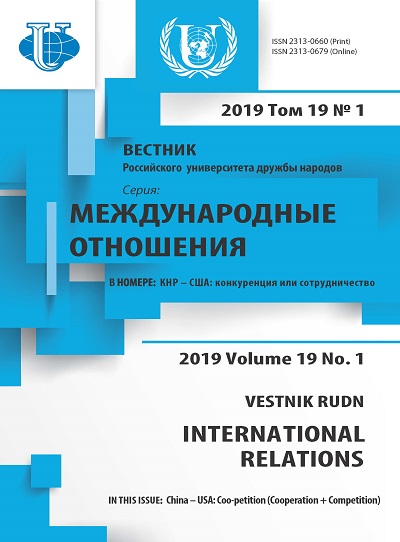USA and China in Latin America: Contours of Competition
- 作者: Yakovlev P.P.1,2
-
隶属关系:
- Institute of Latin America of the Russian Academy of Sciences
- Plekhanov Russian University of Economics
- 期: 卷 19, 编号 1 (2019): China — USA: Coo-petition (Cooperation + Competition)
- 页面: 47-58
- 栏目: THEMATIC DOSSIER
- URL: https://journals.rudn.ru/international-relations/article/view/20851
- DOI: https://doi.org/10.22363/2313-0660-2019-19-1-47-58
如何引用文章
全文:
详细
In the last decade Latin America in trade, economic and financial terms turns out to be increasingly “sandwiched” between the United States and China, which accounted for more than half of the total trade of Latin American countries, and also a crucial part of entering the region investment and credit resources. This circumstance has the strongest impact on the structure and orientation of foreign economic relations and foreign policy contacts. In the foreseeable future one of the complexities of foreign policy of the Latin American countries will be delaying action between the United States and China, are becoming involved in hybrid war for dominance in the global economy and trade. In Latin American capitals the USA-Chinese rivalry at the global level are watched with suspicion and fear. It is connected not only with the current situation, but with the dynamics of relations between Washington and Beijing, the intensification of contradictions at the global and regional levels. Latin Americans believe that initiation of trade wars and other kinds of American-Chinese confrontation could harm the development of the world economy and harm the crucial interests of the region, which is critically dependent on international goods and financial markets. The main challenge is the diversification of international relations of the Latin American States, the broadening of their economic and political partners. Only in this way can be weakened the hyper dependence of Latin America from Washington and Beijing, and reversed the negative effects of the ongoing protectionist policies and trade wars initiated by the administration of Donald Trump.
作者简介
Petr Yakovlev
Institute of Latin America of the Russian Academy of Sciences; Plekhanov Russian University of Economics
编辑信件的主要联系方式.
Email: petrp.yakovlev@yandex.ru
Doctor of Economics, Chief of the Center of Iberian Studies of the Institute of Latin America, Russian Academy of Sciences; Professor of the Department of International Business and Customs, Plekhanov Russian University of Economics
参考
- Allison, G. (2017). Destined for War: Can America and China Escape Thucydides’s Trap? New York: Houghton Mifflin Harcourt.
- Borzova, A.Yu., Torkunova, Yu.A. & Agayev, Yu.I. (2018). China-SELAK: new trends in economic cooperation. Latin America, 7, 32—46. doi: 10.31857/S0044748X0000022-3. (In Russian).
- CEPAL. Explorando nuevos espacios de cooperación entre América Latina y el Caribe y China. (2018). Santiago: Naciones Unidas.
- Chi-Kwan, M. (2012). China and the World since 1945: An International History. London: Routledge.
- Fernandez, J. & Hogenboom, B. (2010). Latin America facing China: South—South Relations beyond the Washington Consensus. New York: Berghahn Books.
- Hansen, R. (1975). Relaciones económicas entre los Estados Unidos y América Latina: ¿bilaterales, regionales o globales? Estudios internacionales. Santiago de Chile, 8 (31), 59—99. doi: 10.5354/0719-3769.2011.17328.
- Holden, R. & Zolov, E. (2000). Latin America and the United States: A Documentary History. London: Oxford University Press.
- Gramer, R. & Johnson, K. (2018). Tillerson Praises Monroe Doctrine, Warns Latin America of ‘Imperial’ Chinese Ambitions. URL: https://foreignpolicy.com/2018/02/02/ (accessed: 23.12.2018).
- Katz, F. (1981). The Secret War in Mexico: Europe, the United States, and the Mexican Revolution. Chicago: University of Chicago Press.
- Latin America in the Contemporary World Policy. (2009). Moscow: Nauka. (In Russian).
- Latin America Confronts the United States: Asymmetry and Influence (2015). Cambridge: Cambridge University Press.
- Lavut, A.A. (2018). A new stage in the Development of Sino-Latin American Relations. Latin America, 12, 59—73. doi: 10.31857/S0044748X0002316-6.
- Mallo, T. & Sanahuja, J.A. (coords.). (2011). Las relaciones de la Unión Europea con América Latina y el Caribe. Madrid: Fundación Carolina/Siglo XXI.
- Palomares, L.G. (2017). Trump y una América Latina en transformación: de la política de muro a la estrategia de sustitución. Revista Tribuna Norteamericana. Alcalá de Henares, 25, 22—29.
- Paz, G. & Roett, R. (2008). China´s Expansion into the Western Hemisphere. Washington: Brookings Institution. Yakovlev, P.P. (2015a). Latin American Role in International Geopolitics. Vestnik RUDN. International Relations, 15 (4), 0—28. (In Russian).
- Yakovlev, P.P. (2015b) Latin America at the turn of trends (experience of understanding new phenomena). Latin America, 7, 4—18. (In Russian).
- Yakovlev, P.P. (2017). “Trump Effect” or the End of Globalization? Moscow: RUSCIENCE. (In Russian).
- Yakovlev, P.P. (2018). USMCA reloaded free trade zone in North America. Latin America, 12, 6—21. (In Russian). doi: 10.31857/S0044748X0002312-2.
- Yakovleva, N.M. (2014). The Nicaraguan Canal for the Happy Future. Latin America, 1, 34—47. (In Russian).
- US Policy Toward China: Recommendations for a New Administration. (2017). New York: Asia Society Center.
- Xu, Yanran (2016). China’s Strategic Partnerships in Latin America: Case Studies of China’s Oil Diplomacy in Argentina, Brazil, Mexico, and Venezuela, 1991—2015. Lexington: Lexington Books.








